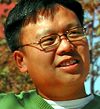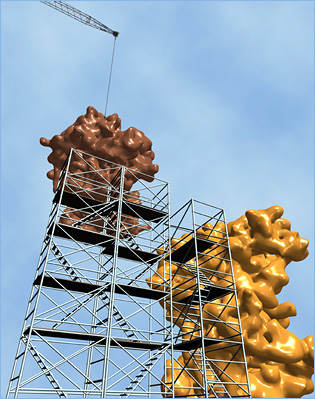
Wendell Lim
A UCSF research team has gained a new glimpse into the circuitry that directs the fate of cells: whether they will grow, change shape or succumb to pathogens.
Cells monitor their environment and make vital decisions by using complex circuits made up of molecules known as signal transduction proteins. One of the most common units used to build these circuits is a class of enzymes called protein kinases, capable of changing the action of other proteins. Different kinases often link together into large cascades or circuits that allow specific cell responses. Cancer, in which cells undergo uncontrolled growth, often progresses by short-circuiting normal kinase cascades.
A major puzzle in biology has been trying to understand how the many different kinds of kinases in a cell normally link together into precisely controlled circuits. Recent research has revealed that they are often physically organized into large assemblies by "scaffolding" proteins that appear to tether a specific set of kinases together. The tethering determines what circuits the different kinases form and the degree of action the circuit exerts on the cell.
A team led by Wendell Lim, PhD, UCSF professor of cellular and molecular pharmacology, reports this week how a scaffold protein interacts with a kinase and shows for the first time that scaffolds can directly affect the activity of a kinase, in addition to passively tethering it to its partners.
 |
| This image represents the structure of two successive kinases in a cellular circuit that are organized by a scaffolding protein. |
The research, based on studies with yeast cells, is reported online this week by
Science Express, published by the journal
Science.
"Our goal is to understand the fundamental design logic of cell-signaling circuits - how they lead to precisely controlled behavior and how new functions evolve," says Lim, senior author of the Science paper and a faculty affiliate of QB3, the
California Institute for Quantitative Biomedical Research, headquartered at UCSF's
Mission Bay campus.
Ways to Create New Cellular Behaviors
"Understanding how scaffold proteins direct kinase signaling is central to understanding how kinases are naturally wired together and what goes wrong in signaling diseases such as cancer," Lim says. "These findings also provide insight into how we might wire kinases together in new ways to create new cellular behaviors."
Lim cites as potential applications the ability to mimic the exquisite level of control and efficiency of cells for use in medicine, energy production and sensing systems.
Lim is a leader in the new field of synthetic biology, which seeks to tease apart the evolved circuitry of cells, both to understand how they are organized and to use this understanding to "redesign" some cells to perform new functions, such as generating valuable drugs and even delivering them efficiently to target cells in the body.
The emerging field was given a boost late last year when the National Institutes of Health (NIH) announced funding for a new Nanomedicine Development Center, run jointly by UCSF and UC Berkeley with Lim as the principal investigator. Called the Center for Engineering Cellular Control Systems, the new program declares that its overall goal is to understand and apply the fundamental design principles of cellular control systems - such as those involving the protein kinases and scaffolding proteins reported in the new Science paper - to engineer cell-like devices with novel "smart" therapeutic functions. NIH is supporting the new center with $7 million over the next five years.
In what is usually a rapid cascade of changes within the cell, individual kinases - each often chemically different from one another - are known to sequentially modify proteins by transferring a unit known as a phosphate group to them, and this change alters the protein's activity. To prevent kinases from acting on the wrong downstream partners, sets of sequential kinases are often wired into assemblies by scaffolding proteins.
The UCSF team was able to determine the three-dimensional structure of a scaffold-kinase assembly, and found that the scaffold protein does not simply tether the kinase, but also directly affects the chemical activity of the kinase. These findings reveal how cells use these types of scaffolding or organizing proteins in many ways to precisely tune the circuit behavior of kinase cascades.
Lead authors on the Science paper are Roby P. Bhattacharyya, PhD, a Medical Scientist Training Program student, and Attila Remenyi, PhD, a postdoctoral fellow in cellular and molecular pharmacology, both at UCSF. Co-authors are UCSF graduate students Matthew C. Good, BS, and Caleb J. Bashor, BS, in cellular and molecular pharmacology; and Arnold M. Falick, PhD, at UC Berkeley.
The research is supported by the NIH, the Sandler Foundation, the Kirch Foundation and the Jane Coffin Child Foundation.
Chris Voigt, PhD, assistant professor of pharmaceutical chemistry and a QB3 faculty affiliate, is another leader in the new field of synthetic biology. He organized a national conference on synthetic biology last summer, held at QB3, and was author of a paper in
Science in November showing how engineering several genes in a microbe could allow living bacteria to create photographs. His research was featured in
New York Times,
Boston Globe,
National Geographic News,
Los Angeles Times and dozens of other news outlets.
Source: Wallace Ravven
Links:
LIM Lab
Center for Engineering Cellular Control Systems
Scientists Engineer Bacteria to Create Living Photographs
Voigt Lab



